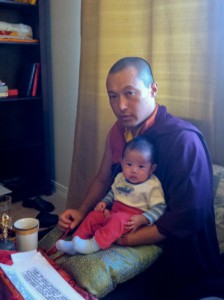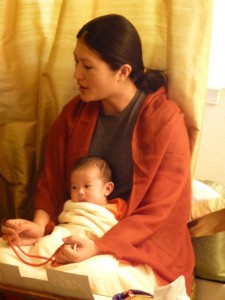Friday
Community ArticlesIncluding Children in Our Practice
As practicing warriors, meditation is a regular part of our lives, and sharing it with our children is an important part of building Shambhala culture. While a child’s interest will vary depending on his or her age and disposition, creating a sense of open invitation to join that part of our lives can help dissolve any barriers around meditation. Often, young children enjoy being included in the practice environment, and it can be sweet to invite them to sit with us, possibly even sharing some very simple instructions on posture. Even two-year-olds can be invited to meditate quietly for a few seconds.
If you say morning or evening chants, children may like to join in, even to play quietly in the room while you chant. Protector chants were a staple of my son Gabriel’s bedtime routine for a while. He liked helping to take out the tea offering, and sometimes we made milk offerings and juice offerings, which were his suggestions. At some point, he lost interest in this routine but still checks the shrine occasionally to see if there’s candy or any good “taste offerings” to steal.
Now that he’s four, when my wife or I practice we always invite Gabriel to come and go from the room as long as he sits with us and doesn’t create trouble. Having this permeable boundary between practice and living spaces can be a bit distracting, but I also find it helpful in softening the overall boundary between practice and life.It’s easy to get caught in a tug of war between our practice and our life duties, because we see them as separate. In meditation, we enjoy the stillness of our minds. At home, we enjoy the simplicity and quiet of our practice space.
But can our sense of peace also accommodate the playful movement of thoughts? Can our domain of practice embrace the playful and chaotic energy of our children? Please, share your experiences of this in the comments section so we can explore this together.
_________________________________________

Noel McLellan is a second generation Shambhala practitioner. He grew up in Boulder, CO where he attended Vidya Elementary School, and later Colorado University. In 1999 he served an 18 month tour of duty as continuity kusung to Sakyong Mipham Rinpoche. In the Dorje Kasung, he holds the rank of Kusung Dapon, senior officer of the Kalapa Court. He now lives in Halifax, Nova Scotia with his wife Marguerite, four-year-old son Gabriel, and nearly-one-year-old daughter Esme. He teaches at the Shambhala School.



















Apr 25, 2011
Reply
Great Article Noel!
Who knew that Kusung practice is the ultimate training for family life?! Gentleness and precision 24/7, with and without sleep, giving up your personal agenda again and again and giving in to enjoy the moments. I loved your comment about how shrine room invasions helped you extend your practice off the cushion. That is a sign of walking the talk. Bravo.
Ps. my kids love the tea offering too.
Feb 27, 2011
Reply
Thank you for this article, lovely. I am a mother of a one-year-old girl and I got quite out of practice since after birth, but this certainly is helpful for how to approach getting back into it and especially doing it together.
And thank you, Terry, for explaining the “breathing game” and how you used it, that sounds great.
Feb 19, 2011
Reply
Great article, thank you very much. I’m mother of 2 kids, 14 and 5, living in Germany. Children are so different! My son always used to get up very early in the morning, so obviously he would find me practicing and joined me sitting on my lap since he was 2 or 3, very fascinated, very concentrated, investigating picture by picture, Mala by Mala, everything. Listeining, tuning in… At the age of 3 1/2, during a refuge ceremony we attended (prior to teachings), he stood up all by himself, walked all the way through the assembly hall to Rinpoche’s throne and sat down among the other refuge candidates. When it was his turn, he just climbed up to the high throne in order for Rinpoche to cut his hair more easily. He has been practicing for years now, even keeping damtsigs. My little daughter howewer hardly shows any interest although we invite her in the same way, just chanting some Mani mantra here and there and enjoying to sit on my lap during meditation sessions because it’s so cosy. She tolerates our habits but doesn’t seem to be much interested so far. The hardest part is to keep my son from showing his disappointment or trying to push her – it will only have the opposite effect…
Feb 19, 2011
Reply
I work in a residential children’s home which caters specifically to kids diagnosed with mental disorder who are in the care of the state. Breathing is often something we teach and encourage them to use as a coping mechanism to help them deal with the symptoms of their disorder (anger, aggression, fear, hallucinations). I often wonder why I have never been able to find a residential program of this type offered by any Buddhist group. There are many programs supported by various other faiths and philosophies. It always seemed to me that a program designed by those who have gained such familiarity and comfort with the mind could have so much impact on these particular children. Does anyone know of one I have overlooked?
Feb 18, 2011
Reply
When I ran my daycare centre I worked mostly with children who were 18 months to 3 years. After I started my meditation practice I started thinking how it might be used with children which resulted in creating the “breathing game”. When I would want the children to transition from active play to quiet play we would start with the “breathing game”. We would all sit in a circle and then I would have them cross their legs, put their hands on their thighs, sit up very straight, chin down and so on. Then I would talk them through taking a deep breath; breath in through your mouth, feel the air in your throat, lungs and alllllll the way down to your belly. (sometimes there were variations: for example, I might get them to put their hands on their belly so they could feel it expand as they breathed in.) Then we would let the breath out with a big whoosh. (this was the fun part for them) We would repeat this deep breathing three times. Then we would sit quietly for a half minute or so. By the time the breathing game was over the children would have gone from being very active to being completely calm. They really loved playing this “game” and looked forward to it.
Once the breathing game became a part of our regular routine I started using it in other ways. For example, if a child was very upset talking them through a few deep breaths helped them calm down. Sometimes I would just have to suggest they take a deep breath. They were always willing to do it since they were so familiar with it.
My goal was to teach them to use or go back to their breath, particularly when they were really wound up or upset. It worked and they loved it.
Feb 18, 2011
Reply
Thanks Noel! As a dad-to-be, I’m very interested in seeing how parents mix practice with their young ones. My wife and I both practice together and look forward to keeping our shrine room door open once baby arrives. Of course, even stepping foot in the shrine room early on may be a little naive on my part!